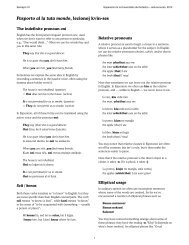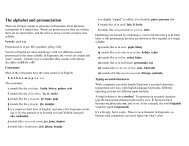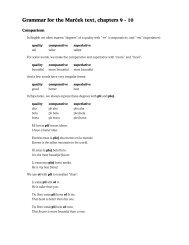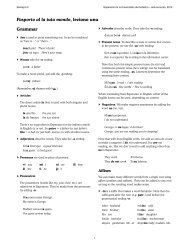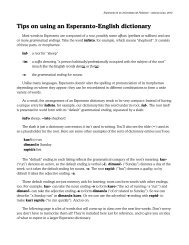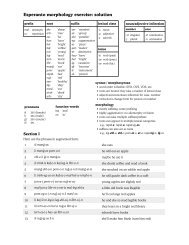Grammar and homework for part four of Pasporto - Esperanto Äe la ...
Grammar and homework for part four of Pasporto - Esperanto Äe la ...
Grammar and homework for part four of Pasporto - Esperanto Äe la ...
Create successful ePaper yourself
Turn your PDF publications into a flip-book with our unique Google optimized e-Paper software.
Semajno 6! <strong>Esperanto</strong> ĉe <strong>la</strong> Universitato de Roĉestro – aŭtuna kurso, 2012<strong>Pasporto</strong> al <strong>la</strong> tuta mondo, leciono kvar (<strong>part</strong>o 1)Subject <strong>and</strong> direct objectSo far we’ve seen lots <strong>of</strong> sentences that express what asubject does or is. For example, here <strong>la</strong> atleto is the subject:La atleto kuras en parko.La atleto estas <strong>la</strong>ca.La atleto ŝvitas.The athlete runs in a park.The athlete is tired.The athlete is sweating.But sometimes we’re concerned not just with what thesubject does, but what it does to something. When we read,<strong>for</strong> example, we must read something; <strong>and</strong> when we eat, wemust eat… something. This “something” is called the directobject, <strong>and</strong> in <strong>Esperanto</strong> we add -n to distinguish it from thesubject:Subject Verb Direct object<strong>la</strong> viro manĝas pomonthe man eats an appleLooking at this sentence, we know what does the eating (<strong>la</strong>viro), <strong>and</strong> we know what is eaten (pomo, because it hasthe -n). The -n allows us to re-arrange the order <strong>of</strong> thesentence without changing its meaning: <strong>la</strong> viro is still theobject, <strong>and</strong> pomon is still the subject, no matter where theyappear in the sentence:La viro pomon manĝas. The man eats an apple.Pomon manĝas <strong>la</strong> viro.Manĝas <strong>la</strong> viro pomon.…etc.The -n can also be added to pronouns:La viro manĝis ĝin.<strong>and</strong> to plurals:Flora havas du kolĉenojn.Ŝi vendos ilin.The man eats an apple.The man eats an apple.The man ate it.Flora has two neck<strong>la</strong>ces.She will sell them.Remember how adjectives “agree” with their nouns bytaking the plural ending -j? (e.g. “ruĝaj pomoj”?) In thesame way, adjectives take the ending -n along with theirnouns:La greka filoz<strong>of</strong>o trinkas minera<strong>la</strong>n akvon.The Greek philosopher drinks mineral water.La <strong>la</strong>ca atleto manĝis tri ruĝajn pomojn.The tired athlete ate three red apples.The -n is also added to words like kio/tio <strong>and</strong> kiu/tiu whenthey represent or indicate an object:Kion manĝas Karlo? —Li manĝas bananon.What is Karlo eating? —He’s eating a banana.Kiun libron legis Jol<strong>and</strong>a?Which book did Jol<strong>and</strong>a read?Kial <strong>and</strong> tialFollowing the pattern <strong>of</strong> kio/tio, kie/tie, kiom/tiom <strong>and</strong> soon, we have kial (why, <strong>for</strong> what reason) <strong>and</strong> tial (there<strong>for</strong>e,so, <strong>for</strong> that reason):Kial li manĝis <strong>la</strong> pomon?Why did he eat the apple?Mi pensas, tial mi ekzistas.I think, there<strong>for</strong>e I exist.Note: don’t confuse tial (there<strong>for</strong>e) with ĉar (because).Mi manĝos, ĉar mi estas malsata.I will eat because I am hungry.Mi manĝis, tial mi ne estas malsata nun.I ate, there<strong>for</strong>e I am not hungry now.The corre<strong>la</strong>tives (tabelvortoj)In English we have a set <strong>of</strong> words to express re<strong>la</strong>ted ideaslike “where”, “there”, “somewhere”, etc.. They follow asemi-regu<strong>la</strong>r pattern:where there somewhere nowhere everywherewhichone…<strong>and</strong> so on.that one someone no one everyonewhen then sometime never alwayshow that way somehow no way every waywhythatreasonsome reasonnoreasoneveryreasonIn <strong>Esperanto</strong>, these words are called corre<strong>la</strong>tives. They als<strong>of</strong>ollow a pattern, but that pattern is completely regu<strong>la</strong>r.You’ve already learned some <strong>of</strong> the corre<strong>la</strong>tives beginningwith ki- <strong>and</strong> ti-.The ki- words generally express “what + something”, <strong>and</strong>the ti- words generally express “that + something”. For1
Semajno 6! <strong>Esperanto</strong> ĉe <strong>la</strong> Universitato de Roĉestro – aŭtuna kurso, 2012example:kio what (thing)tio that thingkiu which one; which person tiu that one; that personkia what kindtia that kind; suchkie where (what p<strong>la</strong>ce) tie there; that p<strong>la</strong>cekiel how (in what manner)kial why (<strong>for</strong> what reason)...tiel that mannertial there<strong>for</strong>e; <strong>for</strong> that reasonNote: be careful not to confuse the endings used <strong>for</strong> makingcorre<strong>la</strong>tives (e.g. -u, -a, -o, -e, etc.) with the grammaticalendings used <strong>for</strong> making nouns, verbs, adverbs, etc. (The -uin kiu, <strong>for</strong> example, is not the same -u in silentu.) Thesystem <strong>of</strong> corre<strong>la</strong>tives is independent <strong>of</strong> the rest <strong>of</strong> the<strong>la</strong>nguage, <strong>and</strong> it follows its own simple set <strong>of</strong> rules.Although we won’t encounter them in this lesson, we canalso make -iĝ words from other <strong>part</strong>s <strong>of</strong> speech:amiko friendedzo husb<strong>and</strong>edzino wifekun withsidi to sitstari to st<strong>and</strong>‣-aĉamikiĝi to become friendsedziĝi to marry (become a husb<strong>and</strong>)edziniĝi to marry (become a wife)kuniĝi to unite, become joinedsidiĝi to become seated, sit downstariĝi to get to one’s feet, st<strong>and</strong> upThe suffix -aĉ is used to denote poorness <strong>of</strong> quality orcondition — it <strong>for</strong>ms words that disparage the thingindicated by the root. As an independent word, aĉameans “rotten”, “lousy”, or “poor in quality”.In addition to ki- <strong>and</strong> ti- words, there are ĉi- words thatexpress “all-something” or “every-something”. Just as withki- <strong>and</strong> ti- words, the ending tells us whether the wordrefers to a person, p<strong>la</strong>ce, thing, etc.:domo houseinfano childĵurnalo newspaperskribi to writedomaĉo hovelinfanaĉo bratĵurna<strong>la</strong>ĉo a “rag”skribaĉi to scribble, scrawlĉioĉiuĉiaĉieĉielĉialeverythingevery one; every personevery kindeverywherein every way<strong>for</strong> every reasonĉiom everything (quantity); all <strong>of</strong>Affixes‣-oblThe suffix -obl is used to denote multiples <strong>of</strong> a number:du two duoble twice (two times)It can also <strong>for</strong>m a word by itself:‣-iĝDek estas oblo de kvin.Ten is a multiple <strong>of</strong> five.The suffix -iĝ expresses a state that has come into being.As an independent word, iĝi means “to become.”We can make -iĝ words from adjectives:trankvi<strong>la</strong> tranquil; calmebria drunk; inebriatedtrankviliĝu! calm down!ebriiĝi to get drunk‣-ulThe suffix -ul denotes a person characterized by the idea<strong>of</strong> the root:stranga strange strangulo a stranger, “weirdo”stulta stupid stultulo an idiot, foolriĉa rich riĉulo a wealthy personWe can add the prefix mal- to these words to makeopposites:malriĉulo a poor personAnd using both -aĉ <strong>and</strong> -ul we can make the pejorativeaĉulo, “a lousy person”, a word that appears in <strong>part</strong> 4 <strong>of</strong><strong>Pasporto</strong>.‣-aĵThe suffix -aĵ denotes something “concrete”: an instanceor manifestation <strong>of</strong> an idea or action.okazi to occurskulpti to sculptnova newtrinki to drinkokazaĵo an eventskulptaĵo a sculpturenovaĵo newstrinkaĵo a beverageAs a st<strong>and</strong>alone word, aĵo means “a (concrete) thing”.2
Praktiko 4.1: Trans<strong>la</strong>te each word/phrase into English.abomeniaĉetasaĉuloaeroafab<strong>la</strong>aferoakceptialiaambu<strong>la</strong>ncoamikoankaŭankoraŭarboatendiatentu!aŭskultiaŭtoaŭto-permesiloaŭtobusobabilisba<strong>la</strong>osbestobildoblekasbotelobrakhorloĝobrakobri<strong>la</strong>certaĉarĉeĉieĉiodankidanĝeradekdekobledem<strong>and</strong>idevasdiligentadiridolorasdomodorsodrinkisduobleebleebriaebriiĝasegaleekzistaselenesperebleeĉfaktefaktur<strong>of</strong>alifarosfinasfinfinefloro<strong>for</strong><strong>for</strong>gesi<strong>for</strong>iru!<strong>for</strong>kurifot<strong>of</strong>reŝafulmog<strong>la</strong>sogratuligravasĝojashaltu!havashelposherbohodiaŭhorohoteloideoiliimaguinstruisinterinterrompiinteresosjajamĵong<strong>la</strong>skafokapdolorokapokaptikarakialkiamkielkinokolĉenokolokompatindakompreneblekonaskorbojkrurojkruĉokulpakun<strong>la</strong>mpolernilingvolistoliteroliterumimankimanomatenomatenmanĝomembromemorasmi petasmontrineimageblenovanuronipagipardononpardonpetaspermesipermesilopetiplenapluporportispostpostepreferasprenaspreparospriprizonoproprovirigardurompassanasatasensenpermesesentosilentu!soifassonojsovaĝastrangastrangulostultastultulosubsupersursurdaŝancoŝo<strong>for</strong>asŝtelitamentempotenasteotietieltondrotratrankvi<strong>la</strong>trankviliĝutretrinkitrotrovostutevarovazoverdirevereverŝividivirinovizitivodkovojovolontevortoSemajno 6! <strong>Esperanto</strong> ĉe <strong>la</strong> Universitato de Roĉestro – aŭtuna kurso, 20123
Semajno 6! <strong>Esperanto</strong> ĉe <strong>la</strong> Universitato de Roĉestro – aŭtuna kurso, 2012Praktiko 4.2: Fill in the b<strong>la</strong>nks with the correct word endings.Flora havas vendej___ kiu estas ver___ internaci___. Ŝi vendas var___ el Eŭrop___ kaj Azio. Sed ŝi havas gr<strong>and</strong>___ problem___:klient___ venas al <strong>la</strong> vendej___, sed ili ne aĉet___ <strong>la</strong> var____, ĉar <strong>la</strong> varoj estas tro multekost___. Kenĝi intervjuas Flor___, seddetektiv___ interrompas ili___. Li montras al ili bild___ de Rusel___. Rusel___ serĉas <strong>la</strong> detektiv___. Kiam li trovos li___, <strong>la</strong>kompatind___ ŝafist___ el Nov-Zel<strong>and</strong>o ir___ al prizon___.Praktiko 4.3: Fill in the b<strong>la</strong>nks.In each problem, the same idea is expressed twice. Here are the verbs to choose from: abomenas, aĉetos, akceptas, finas,<strong>for</strong>gesis, havas, ĵong<strong>la</strong>s, montras, preferas, ŝte<strong>la</strong>s, trinkas, trovis.1. Mankas al mi mono! Mi ne __________ monon!2. “Rigardu! Jen be<strong>la</strong> vazo!” diras Flora. Ŝi ______ ĝin alGeorgo.3. Tri pomoj dancas en <strong>la</strong> manoj de Karlo. Li _______ ilin.4. “Tre malp<strong>la</strong>ĉas al mi ŝafoj. Mi ________ ilin!”5. “Mi serĉis ĉie; kie ĝi estas, kie?Ha, jen ĝi! Mi ______ ĝin!”6. “Hmm”, pensas Georgo: “Mi ne scias! Mi sciis hieraŭ!Mi ______ lian nomon.”8. Georgo estas soifa; kaj jen <strong>la</strong> sovaĝa akvo!Glut’, glut! Li ________ ĝin.9. Danĝera ulo venas kaj prenas monon de Ruselosenpermese. Li ________ ĝin.10. Karlo kuras kaj kuras. Je <strong>la</strong> dua horo li haltas.Li ________ <strong>la</strong> kuradon.11. “Ne! Tiu vazo ne estas por mi!” diras Georgo.Li ne ________ ĝin.12. “Kafo estas bona, sed teo estas tre bona.Mi ___________ teon.”7. La kosto estas 20 steloj. Ĉu vi ______ ĝîn?Praktiko 4.4: Fill in the b<strong>la</strong>nks.1. “T_______ ŝ_______!”Kion faras Kenĝi? Li t________ ŝ________.2. “Pr________ a________ p_______ ŝ______.”Kion faras Kenĝi? Li p______ b______ da a_______.3. “Sinjorino ne trinkos el botelo. P______ gl______.”Kion faras Kenĝi? Li _______ _______.4. “V_____ <strong>la</strong> ______n!”Kion faras Kenĝi? Li v_______ _____ _______.5. “Tr______ <strong>la</strong> a_______n!”Kion faras s-ino Bundo? Ŝi t_______ ____ ________.6. “Diru vian nomon!”“Ve! Terure! Katastr<strong>of</strong>e!”“Strangaj nomoj!”“Ne! Vi ne komprenas. Ŝia nomo estas Flora.”“L__________ ĝ_____, mi p________.”“Fo, Lo, O, Ro, A.”Kion faris Kenĝi? Li l__________ ŝian _______.4



